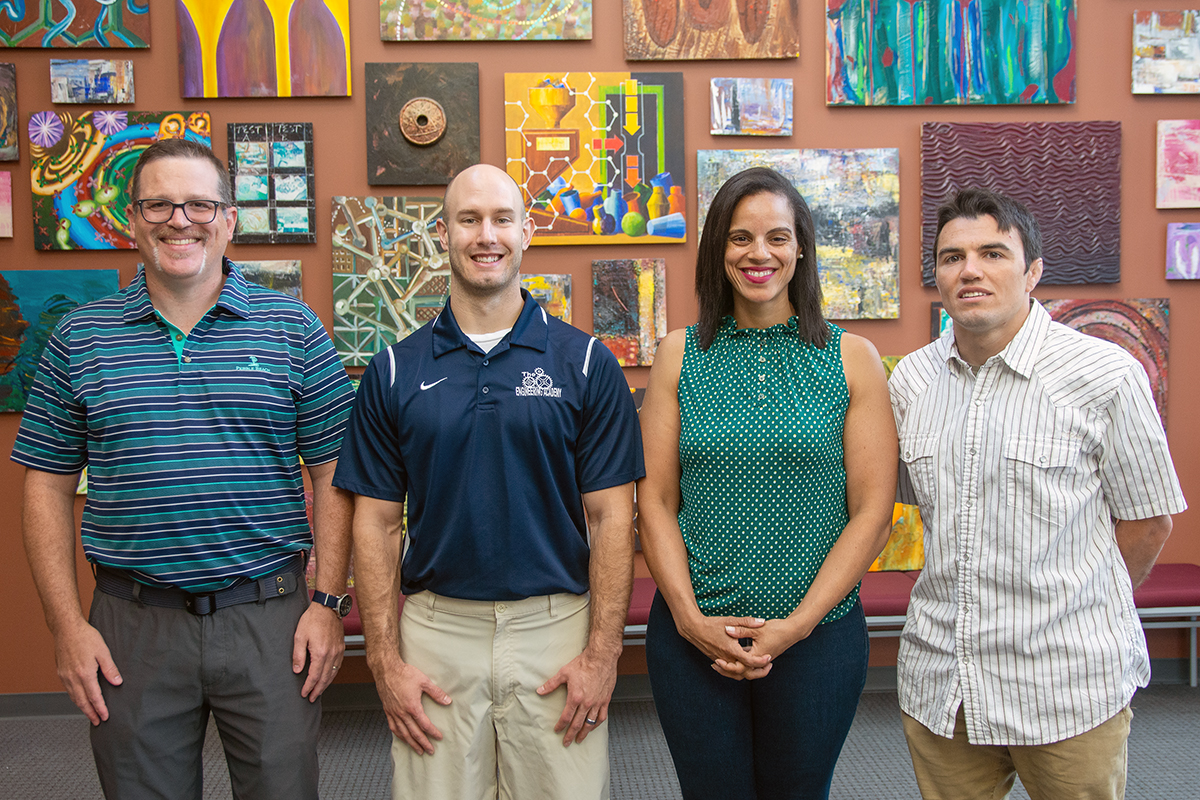Research Experience for Teachers Program continues to provide value, growth, and learning for participants

Pictured left to right: Dr. Kevin Cavicchi, David Helmick, Marjorie Hill-Langston, and Chris Kriebel
The College of Polymer Science and Polymer Engineering’s Akron Global Polymer Academy (AGPA) recently concluded the 2019 Research Experience for Teachers in Polymer Engineering (RET) program. This program, funded by NSF Award Number EEC-1542358, sponsored four high school science teachers who worked for eight weeks conducting polymer research in a lab of a CPSPE faculty member. By the end of the program, these teachers developed new lesson plans to introduce STEM to their classrooms in innovative ways.
This year’s participants were part of the 2018 RET program, which allowed them to work with the same faculty advisor from the previous year and gave them the opportunity to delve deeper into their individual research focus topic.
After another successful summer, here are some things the teachers had to share:
“The RET program this summer provided another round of valuable learning, networking, and scientific experiences to strengthen my teaching background. I have gained enormous amounts of invaluable learning from participating in this program. I am extremely thankful for the opportunities provided from the Polymer Outreach Program and The University of Akron.
“Specifically, this summer I was given the opportunity to learn about SEBS (Styrene Ethylene Butylene Styrene). We worked to produce a thin film of SEBS that we could use to place on the print bed of a 3D printer to see if it would help the print qualities of hard to print Polymers such as HDPE (High Density Polyethylene). I learned how to use an optical microscope to take photos of the films we made for analysis as well as learn more about the internal stresses created through the 3D printing process. These are the concepts and knowledge that I get to bring back and share with my Engineering Students taking Polymer Testing at Stow High School.” – David Helmick
“The University of Akron RET program has provided me with an opportunity to grow as a science teacher. It has given me the ability to study water quality, spectrometers, and the scientific process in an all-encompassing atmosphere. It provided the platform to create a unique lesson plan that will be shared with students. It is an experience of which I am exceptionally grateful.” – Erika Smeader
“I would like to thank The University of Akron and their staff for the opportunity to participate in the RET program this year. This program is fantastic! Not only does It provide teachers with the opportunity to get their hands wet in research, but also gives them the ability to create an original lesson plan for their classrooms. This program increases the teacher’s repertoire and provides the students with an enriched classroom experience.
“The lesson I will be publishing this year challenges students to create an artificial ligament. The ligament the students will be making is a composite polymer material. What I find even more valuable than the lesson I have created is the device that I have built to test the strength of the composite. The device that I have built is one that all teachers can replicate for a fraction of the cost of what they sell for.” – Chris Kriebel
“I am extremely grateful for another RET experience at the University of Akron! Thanks to my RET experiences, I and my students have been impacted in ways no other professional development program has in twenty years of teaching. I have also been impacted personally. The NSF RET community has made me feel valued when key others haven't, and, thus, are a big part of my remaining in this profession. This summer, we continued to make aerogels, but now we moved to making films of varying thicknesses rather than monoliths (cylinders). We made both SPS and polyimide aerogels films. We made neat, surfactant free emulsion-templated, and surfactant emulsion templated polyimide aerogel film samples. We evaluated the effects of different crosslinkers (TAB and TREN), different dispersed phases (cyclohexane, n-heptane, and silicone oil), and different ratios of dispersed and continuous phases. We did this in an effort to expand the range of the size of the pores created in the aerogels in an effort to expand the air filtering capabilities of the aerogels. In my lesson, my students will make meringue cookies in the shape of thin films. They will then test their filtering capabilities and then produce an improved meringue aerogel film filter.” – Marjorie Hill-Langston
RET is led by John Fellenstein, Content Specialist for AGPA, and Dr. Kevin Cavicchi, the principal investigator on the RET Site and Associate Dean of Academic Affairs for the College of Polymer Science and Polymer Engineering.
